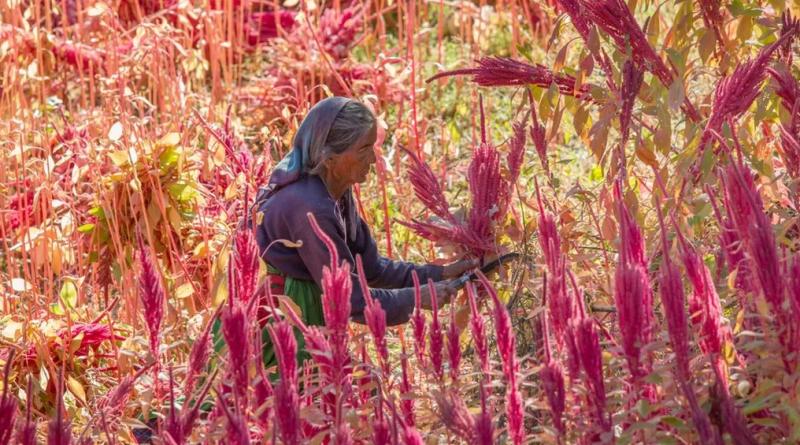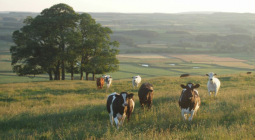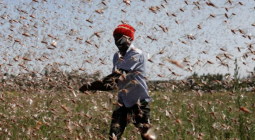‘It could feed the world’: amaranth, a health trend 8,000 years old that survived colonization

Indigenous women in North and Central America are coming together to share ancestral knowledge of amaranth, a plant booming in popularity as a health food
just over 10 years ago, a small group of Indigenous Guatemalan farmers visited Beata Tsosie-Peña’s stucco home in northern New Mexico. In the arid heat, the visitors, mostly Maya Achì women from the forested Guatemalan town of Rabinal, showed Tsosie-Peña how to plant the offering they had brought with them: amaranth seeds.
Back then, Tsosie-Peña had just recently come interested in environmental justice amid frustration at the ecological challenges facing her native Santa Clara Pueblo – an Indigenous North American community just outside the New Mexico town of Española, which is downwind from the nuclear facilities that built the atomic bomb. Tsosie-Peña had begun studying permaculture and other Indigenous agricultural techniques. Today, she coordinates the environmental health and justice program at Tewa Women United, where she maintains a hillside public garden that’s home to the descendants of those first amaranth seeds she was given more than a decade ago.
They are now six-foot-tall perennials with flowering red plumes and chard-like leaves. But during that first visit in 2009, the plants were just pinhead-size seeds. Tsosie-Peña and her guests spent the day planting, winnowing, cooking and eating them – toasting the seeds in a skillet to be served over milk or mixed into honey – and talking about their shared histories: how colonization had separated them from their traditional foods and how they were reclaiming their relationship with the land.
Since the 1970s, amaranth has become a billion-dollar food – and cosmetic – product. Health conscious shoppers embracing ancient grains will find it in growing numbers of grocery stores in the US, or in snack bars across Mexico, and, increasingly, in Europe and the Asia Pacific. As a complete protein with all nine essential amino acids, amaranth is a highly nutritious source of manganese, magnesium, phosphorus, iron and antioxidants that may improve brain function and reduce inflammation.
“This is a plant that could feed the world,” said Tsosie-Peña.
For her it also has deep cultural value. She is part of growing networks of Indigenous women across North and Central America who have been sharing ancestral knowledge of how to grow and prepare amaranth. Seed exchanges, including those in New Mexico and California, are part of a larger movement to reclaim Indigenous food systems amid growing recognition of their sustainability and resilience in a time of climate crisis and industrialized agriculture.
“Supporting Indigenous people coming together to share knowledge” is vital to the land back movement, a campaign to reestablish Indigenous stewardship of Native land, and liberation of Native peoples, Tsosie-Peña said. “Our food, our ability to feed ourselves, is the foundation of our freedom and sovereignty as land-based peoples.”
This is a story of two histories: the remarkable survival of amaranth through colonization and the women like Tsosie-Peña who, in the last 20 years, have expanded networks of Indigenous people celebrating its ancient cultivation.
Seeds hidden under floorboards
Amaranth is an 8,000-year-old pseudocereal – not a grain, but a seed, like quinoa and buckwheat – indigenous to Mesoamerica, but also grown in China, India, south-east Asia, west Africa and the Caribbean. Before the Spanish arrived in the Americas, the Aztecs and Maya cultivated amaranth as an excellent source of proteins, but also for ceremonial purposes. When Spanish conquistadors arrived on the continent in the 16th century, they threatened to cut off the hands of anyone who grew the crop, fearing that the Indigenous Americans’ spiritual connection to plants and the land might undermine Christianity. Yet, farmers continued secretly growing amaranth, which sprouted up like a weed in their fields – even as far north as the modern-day United States.
Although the Spanish outlawed amaranth when they arrived in Central America, Mexico and the south-western United States, Indigenous farmers preserved the seeds – which grew with remarkable resilience.
In Guatemala, amaranth faced another near-extinction when state forces began targeting the Maya people, and burning their fields, during the 1960-1996 civil war. To preserve their traditional foods, Mayan farmers poured handfuls of seeds into glass jars to bury in their fields or hide under floorboards. One such farmer was Magaly Salazar, a Maya K’iche’ woman from San José Poaquil, who hid a small glass jar of amaranth seeds behind one of her ceiling tiles. After the civil war, when it felt safe to start growing amaranth again, Salazar retrieved her seeds and started sharing them with other farmers.
In 2004, Sarah Montgomery, a New Mexican who’d moved to Guatemala to do food justice work with Mayan women, read about Salazar’s seeds and invited her to Rabinal, where a few dozen mostly female, survivors of the armed conflict had formed an agricultural community called Qachuu Aloom – Maya Achì for “Mother Earth”.
When Salazar and a friend arrived in Rabinal, they distributed their amaranth seeds among members of Qachuu Aloom and began teaching them how to plant and cook amaranth. But as they gardened, speaking in a mix of Maya Achì and Maya K’iche’, the women began exchanging stories of surviving the conflict. At one point, Montgomery overheard one of the women say, “We had no idea that what happened to us was happening to other people.” Today, Salazar’s seeds are growing in hundreds of Guatemalan gardens – Qachuu Aloom has grown to include more than 400 families from 24 Guatemalan villages – as well as in Tsosie-Peña’s yard and a public garden in northern New Mexico.
While amaranth is no longer banned, Tsosie-Peña says “planting it today feels like an act of resistance”. Reestablishing relationships with other Indigenous communities across international borders is part of a “larger movement of self-determination of Indigenous peoples”, she says, to return to the “alternative economies that existed before capitalism, that existed before the United States”.
‘I remember my grandma planting this’
Tsosie-Peña first saw amaranth growing in her pueblo at her good friend Roxanne Swentzell’s house. The president of the Flowering Tree Permaculture Institute, Swentzell was teaching classes on how to garden in the high desert and also doing work around seed saving. Tsosie-Peña was interested in learning more, and in 2008 she received her Indigenous sustainable design certification from the Traditional Native American Farmers Association in Tesuque Pueblo. Montgomery was at the workshop and introduced the class to a handful of farmers from Qachuu Aloom. The next year, members of Qachuu Aloom made that trip to Santa Clara to plant amaranth in Tsosie-Peña’s garden.
Every year since then, Guatemalan farmers with Qachuu Aloom have traveled to the United States to share their knowledge of amaranth with predominantly Indigenous- and Latino-led gardens. In California, they’ve shared seeds with members of the Bishop Paiute Tribe and with urban gardens in Los Angeles; and in northern New Mexico, they’ve hosted gardening and cooking workshops in the rural community of La Madera. In 2016, when Tsosie-Peña and her colleagues at Tewa Women United broke ground on their public garden in Española, Qachuu Aloom was there to plant amaranth once again.
But Qachuu Aloom hasn’t always been the one bringing seeds – many Indigenous gardeners, such as Tsosie-Peña’s friend Roxanne Swentzell, have preserved their own amaranth. On the Hopi reservation in Arizona, for example, members of Hopi Tutskwa Permaculture still grow Hopi Red Dye Amaranth, and have shared it with Qachuu Aloom.
Tsosie-Peña says that this exchange between North and Central American farmers isn’t just about amaranth as a crop; it’s also about reconnecting to ancient trade routes that have been disrupted by increasingly militarized borders.
Maria Aurelia Xitumul, a member of Qachuu Aloom since 2006 who has traveled on exchanges to California and New Mexico, echoes Tsosie-Peña. “The goal is to share experiences, not necessarily generate income, like capitalists. What we want is for the whole world to produce their own food,” she said in Spanish. “For the seeds, distance doesn’t exist. Borders don’t exist.”
Montgomery says she noticed the presence of borders in a different way when coordinating Qachuu Aloom workshops in California: many of the people they began working with in community gardens were very recent immigrants from Central America and Mexico. Their memories of amaranth were fresh. Montgomery recalls one participant seeing the amaranth and exclaiming, “I remember my grandma planting this.”
She also began noticing participants in different workshops she hosted – such as one with African refugees who’d settled in Albuquerque – connecting with the amaranth. It seemed like it had grown all over the world, but come and gone with cycles of colonization.
“There was a lot of really similar stories of colonization and how seeds were taken in these different places, how similar strategies were used to make seeds disappear, and create this domination and dependency,” Montgomery said. “But the thing about amaranth is, it comes up everywhere.”
A ‘superweed’
In 2010, the New York Times published an article about the looming threat of superweeds – weeds which have developed to be resistant to Roundup–including amaranth. When sprayed on a field, Roundup is designed to kill all plants except Monsanto’s genetically-engineered Roundup Ready crops. But, somehow amaranth has survived – just like it did during the Spanish conquest.
“You can grow it in Hispaniola, you can grow it in northern New Mexico and the mountains of Guatemala,” says Montgomery. Xitumul was shocked when she visited the Hopi reservation in Arizona and saw how well it grew in the arid climate so different from her forested home town.
A single amaranth plant produces hundreds of seeds – something that the farmers of Qachuu Aloom celebrated when the small handful of seeds Magaly Salazar sequestered away turned into hundred-pound bags of harvest the next season.
For many Indigenous farmers in Guatemala and the United States, growing amaranth has provided a degree of economic independence, but it has also offered a route to food sovereignty.
“Amaranth has completely changed the lives of families in our communities, not only economically, but spiritually,” said Xitumul. Growing traditional crops has allowed many Guatemalan farmers – herself included – to support their families from their ancestral homes, rather than working in Guatemala City or coastal coffee and banana plantations.
More recently, during the pandemic, Xitumul said that people with their own gardens, especially in communities that had long lockdowns, felt more secure knowing they had control over their food supply. In northern New Mexico, many pueblos, including Tsosie-Peña’s, implemented strict quarantines. To support her neighbors in navigating a food desert, Tsosie-Peña distributed seeds at the outset of the pandemic.
The week before the emergency declaration of the pandemic Tsosie-Peña was in Guatemala. When international borders began closing, she had to rush home to the United States. But a few months ago, after vaccines were widely distributed in the US, she and a handful of delegates from each of the farms that had begun planting Qachuu Aloom’s seeds traveled back to Guatemala. With them, they brought seeds from the amaranth they had each grown in their home gardens – descendants of Qachuu Aloom and Magaly Salazar’s seeds – to plant in a shared plot: a kind of solidarity garden.
“We’ve always viewed our seed relatives as relatives and kin,” says Tsosie-Peña. “We have co-evolved with them as fellow Indigenous peoples of this place.”
Cecilia Nowell in Albuquerque, New Mexico
PHOTO: An elderly woman cuts an amaranth crop, in Uttarakhand, India. The plant is indigenous to North and Central America but also grown in China, India, Southeast Asia, West Africa and the Caribbean. Photograph: Hitendra Sinkar/Alamy Stock Photo





